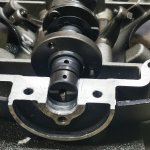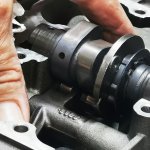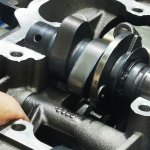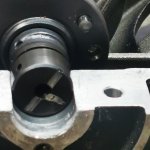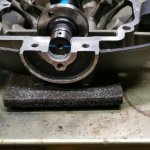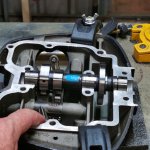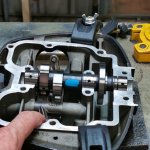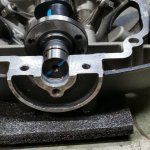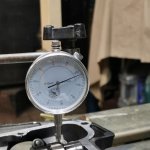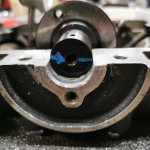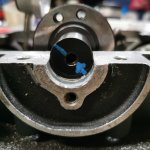You are using an out of date browser. It may not display this or other websites correctly.
You should upgrade or use an alternative browser.
You should upgrade or use an alternative browser.
Cam Noise
- Thread starter Dool
- Start date
No, feeler gauge go in at the rightmost part of the graph, the last 360. That is TDC in combustion phase. poin1 1 is TDC in exhaust phase and point 2 is inlet valve opening.Which point does the Feeler Gauge go in ? 1,2
You do like pie but I don't know how to cook it!Well that just shows I cant read Graphs
Can you do the Same in Pie Graph ? , I like Pies
I think you could go tighter on the exhaust (don't remember the number by heart) but since you're in the middle of the summer I'd leave them as they are!Less visuals so you can concentrate on the Noise, this after the miniscule amount of Tightening of the Inlet
Tonight I sat a Cam in a upside down Cam cover. An OEM Cam as you can see.
Firstly I positioned the Cam in what would be "T" mark and the pic shows the Horizontal line as expected.
then I show where the Cam Lobe actually is in relation to the Rocker, where we stet the Clearance.
Then I position the rocker at the bottom of the Lobe and show the position of the Cam again, you can seed the difference, the Line is not Horizontal
Firstly I positioned the Cam in what would be "T" mark and the pic shows the Horizontal line as expected.
then I show where the Cam Lobe actually is in relation to the Rocker, where we stet the Clearance.
Then I position the rocker at the bottom of the Lobe and show the position of the Cam again, you can seed the difference, the Line is not Horizontal
Attachments
Then remembering to wipe the Lense I did the same with High lift Long duration Cam
So the pics show the same situation as above.
So the pics show the same situation as above.
Attachments
OK @Dool no I finally understood what you meant at the beginning!Tonight I sat a Cam in a upside down Cam cover. An OEM Cam as you can see.
Firstly I positioned the Cam in what would be "T" mark and the pic shows the Horizontal line as expected.
then I show where the Cam Lobe actually is in relation to the Rocker, where we stet the Clearance.
Then I position the rocker at the bottom of the Lobe and show the position of the Cam again, you can seed the difference, the Line is not Horizontal
I haven't changed so many cam to be so familiar with them! Anyhow now I see your point. Indeed you could be already into the lobe zone when you adjust the tappets, at this point. So what to make of it? I don't know yet, I need to study a bit more!
Could it be the case that now you have to make tappet adjustment to specific points in the crankshaft position? If so this could be interesting to evaluate since there is also a 2:1 ratio to consider between the angle at the crank and the camshaft angles.
The good thing is that this position should be more or less the same for all cams, since the maximum lift should happen more or less always at the same crank angle and thus the back of the lobe should be always in the same crank angle.
Does it make sense to you? Now how can we achieve that? Shall we make other "T" marks? Whe surely need a graduated disk to accomplish that!
Anyhow very clever observation!
@Dool do you have the possibility to measure the difference in height with a comparator?
What I mean is if you could do the following measurement:
Does it make sense?
What I mean is if you could do the following measurement:
- Put the cam into the cover on two v-blocks (if you have them, or any other mean to keep the axis of the cam straight and allow rotation)
- Then zero the comparator on the part opposite to the lobe maximum for inlet (or outlet, should be the same but must be verified)
- Then turn the cam till the point where you'd normally adjust the tappets
- read the comparator value.
Does it make sense?
If I had Vee blocks I would not have needed to use the Cam Cover 
Next time I adjust my tappets ( no doubt I will have a Hot Cam ) I will take my time and do it taking this into consideration.
This helps explain the Noises reported from the area
Making the Lobe different has follow on effects as all of this must still occur in the same 360 deg so to not expect an increase in Noise would be Naive. Who ever heard a quiet Hot Rod ?
Next time I adjust my tappets ( no doubt I will have a Hot Cam ) I will take my time and do it taking this into consideration.
This helps explain the Noises reported from the area
Making the Lobe different has follow on effects as all of this must still occur in the same 360 deg so to not expect an increase in Noise would be Naive. Who ever heard a quiet Hot Rod ?
It is true that one point at which you surely want the tappets to be away from the cam is at compression TDC, otherwise you risk loosing compression during the ignition process... Usually that's why you make the adjustment there, regardless of the lobe shape.If I had Vee blocks I would not have needed to use the Cam Cover
Next time I adjust my tappets ( no doubt I will have a Hot Cam ) I will take my time and do it taking this into consideration.
This helps explain the Noises reported from the area
Making the Lobe different has follow on effects as all of this must still occur in the same 360 deg so to not expect an increase in Noise would be Naive. Who ever heard a quiet Hot Rod ?
A compression test before and after tappet adjustment could shed some light on the matter.
Or probably we just have to live with a slightly noisier bike...
Okay this is not definitive because the cheap fold up Welding bench is not ridged enough for Science.
The Gauge shows the variation between TDC or the "T" mark and the back of the Lobe true.
Im not going to lose any more sleep over this
Not bad for an Old Bloke
The Gauge shows the variation between TDC or the "T" mark and the back of the Lobe true.
Im not going to lose any more sleep over this
Not bad for an Old Bloke


